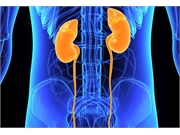Experts say risk overstated for use of IV iodinated contrast media in patients with reduced renal function
WEDNESDAY, Jan. 22, 2020 (HealthDay News) — In consensus statements from the American College of Radiology and the National Kidney Foundation, published online Jan. 21 in Radiology, recommendations are presented for the use of intravenous iodinated contrast media with computed tomography (CT) for patients with kidney disease.
Noting that many cases of acute kidney injury (AKI) incorrectly have been thought to be induced by intravenous iodinated contrast media, Matthew S. Davenport, M.D., from Michigan Medicine in Ann Arbor, and colleagues provide recommendations for its use in patients with various degrees of impaired kidney function.
Although the risk for contrast-induced AKI remains uncertain for patients with severe kidney disease, the authors recommend that for patients with AKI or an estimated glomerular filtration rate <30 mL/min/1.73 m² who are not undergoing maintenance dialysis, prophylaxis with intravenous normal saline is indicated. Prophylaxis may be considered in patients with an estimated glomerular filtration rate of 30 to 44 mL/min/1.73 m² at the discretion of the ordering physician in individual high-risk circumstances.
“A primary explanation for the exaggerated perceived nephrotoxic risk of contrast-enhanced CT is nomenclature,” Davenport said in a statement. “‘Contrast-induced’ acute kidney injury implies a causal relationship. However, in many circumstances, the diagnosis of contrast-induced-AKI in clinical care and in research is made in a way that prevents causal attribution. Disentangling contrast-induced AKI (causal AKI) from contrast-associated AKI (correlated AKI) is a critical step forward in improving understanding of the true risk to patients.”
Copyright © 2020 HealthDay. All rights reserved.








